Section 5: Family violence against seniors
By Shannon Brennan
- One-third of all violent crimes committed against seniors are family-related
- Family violence against seniors highest in the western provinces
- Family violence against seniors higher in non-census metropolitan areas
- Family violence against seniors most often committed by a grown child
- Common assault most common type of family violence against seniors
- Most family violence against seniors involves physical force or threats
- Family violence against seniors most often results in charges
- Rate of family-related homicide against seniors has decreased over past 30 years
- Summary
- Detailed data tables
- References
- Notes
Population projections have indicated that the number of seniors living in Canada will grow considerably over the coming decades. Between 2006 and 2011 alone, the number of Canadians aged 65 and older increased by 14%, and now totals close to 5 million people (Statistics Canada 2012).
Historically, seniors have experienced the lowest rates of victimization. However, there are mounting concerns that the growth of the senior population may result in increased victimization and violence against this group (Sev'er 2009). As a result, many provinces are developing strategies to address this issue. As family members often assume the role of caregiver for aging seniors, many of the strategies focus on preventing violence within families (see, for example, Province of British Columbia 2013, Together to Reduce Elder Abuse – B.C.'s Strategy).
Using police-reported data from the Uniform Crime Reporting (UCR) Survey, this section will present information on the nature and extent of family violence against seniors. It will examine the prevalence of family violence against seniors at the national, provincial/territorial and census metropolitan area levels. In addition, this section will explore the characteristics of family violence against seniors, presenting information on the most common types of violence experienced, the use of weapons, injuries sustained and how these incidents are cleared by police. Finally, this section will conclude with a discussion of homicide, the most serious form of family violence against seniors.
One-third of all violent crimes committed against seniors are family-related
In 2011, about 8,500 senior CanadiansNote 1 (aged 65 years and older) were the victim of a violent crime. More than one-third (34%) of these were victimized by a family member, while just under one in five (19%) were victimized by a casual acquaintance. More than one-quarter (27%) of seniors who had been victimized in 2011 were victimized by a stranger.
In total, there were more than 2,850 senior victims of family-related violence in 2011, representing 61 senior victims per 100,000 population (Table 5.1). Data from a subset of police services shows that violence against seniors has remained stable over the past three years.
Compared to other victims, those aged 65 and older have consistently reported the lowest rates of family-violence, a trend which continued in 2011. Among both men and women, the rate of family violence against seniors was considerably lower compared to victims of other ages. For example, the rate of family violence among senior women was close to 10 times lower than the rate for women aged 25 to 34 (Chart 5.1).
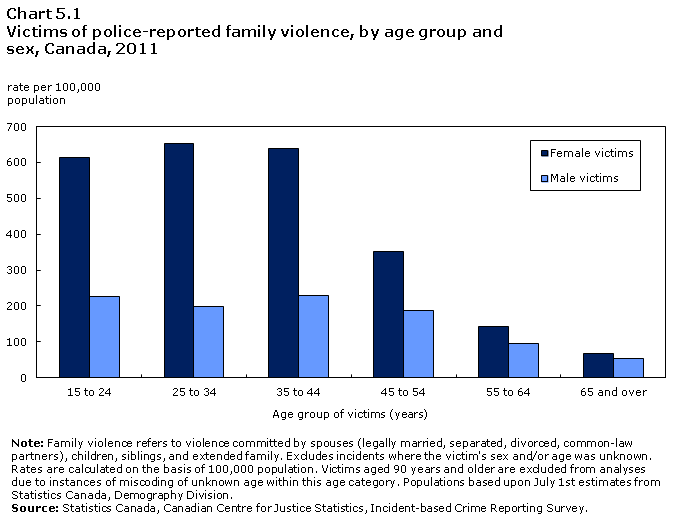
The rate of police-reported family violence was not the same for all seniors. Just as younger Canadians were at greater risk of experiencing family-related violence compared to seniors, younger seniors were at greater risk compared to older seniors. For example, those aged 65 had a rate of police-reported family violence that was three and a half times higher than the rate for those aged 89 (Chart 5.2).
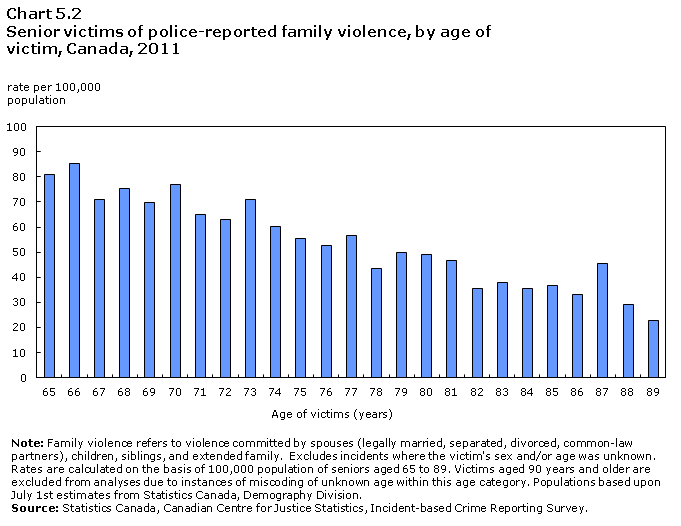
Rates of family-violence against seniors also differed depending on the sex of the victim. In 2011, the rate of family violence against senior women was higher than the rate of family violence for senior males (67 versus 53 per 100,000 population).
Family violence against seniors highest in the western provinces
Similar to crime in general, rates of family violence against seniors in 2011 were highest in the territories and the western provinces (Table 5.2, Chart 5.3). Saskatchewan, Alberta and Manitoba reported the highest rates among the provinces, while Nunavut reported the highest rate among the territories. In contrast, Prince Edward Island had the lowest rate of police-reported family violence against seniors, followed by Ontario and Quebec.
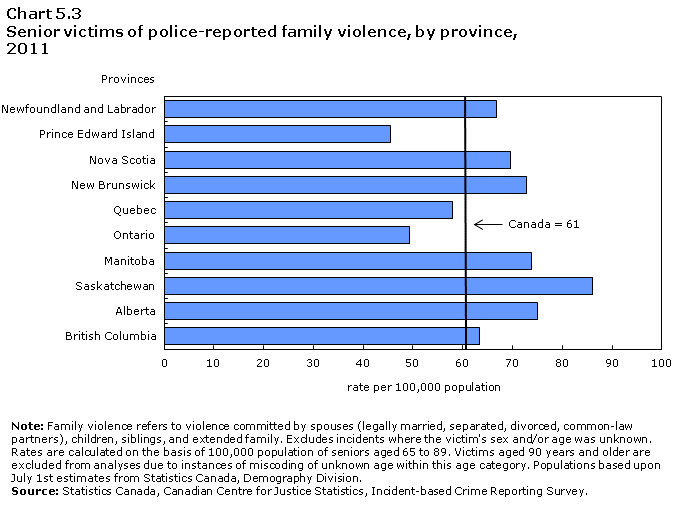
While there was variation among the provinces in regards to the prevalence of family violence against seniors, there were also differences based on the sex of the victim. More specifically, although data at the national level indicate that senior women are at elevated risk of experiencing family violence, this was not true for all provinces. For example, senior men living in Newfoundland and Labrador, Prince Edward Island, Nova Scotia, New Brunswick and Saskatchewan were more likely than senior women to be a victim of family violence (Table 5.2).
Family violence against seniors higher in non-census metropolitan areas
Previous studies have found that family violence against seniors tends to be lower in census metropolitan areas (CMAs) compared to smaller towns and cities (Sinha 2012). This was also found to be the case in 2011 (Table 5.3). The rate of family violence against seniors in CMAs was 53 per 100,000 population, considerably lower than the rate in non-CMAs (76 per 100,000 population). There are a variety of factors which may help to explain the higher prevalence of family violence against seniors in smaller towns, cities and rural areas, including geographic isolation and fewer resources (Grama 2000).
Among the 33 CMAs, Gatineau reported the highest rate of family violence against seniors, followed by Brantford, St. John's and Kitchener-Cambridge-Waterloo. Conversely, the lowest rates of family violence against seniors were reported in the CMAs of St. Catharines-Niagara, Sherbrooke, Hamilton and Windsor (Chart 5.4).
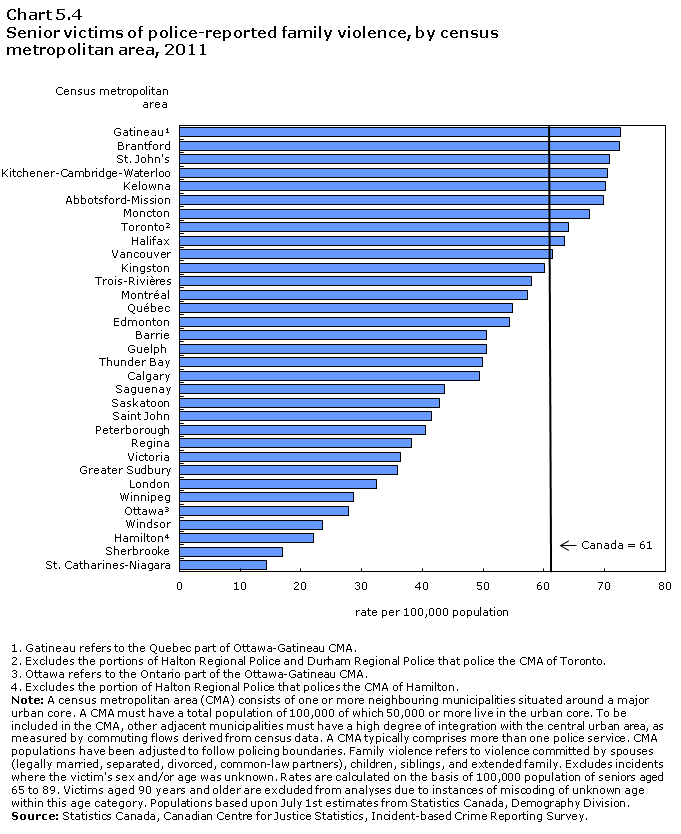
Family violence against seniors most often committed by a grown child
Previous research in the area of family-violence against seniors has found that those aged 65 and older are most at risk of being victimized by a grown child, a trend which continued in 2011. The police-reported rate of seniors victimized by a grown child was one and a half times higher than the rate victimized by spouses, who were the second most common perpetrators of family violence against seniors (Table 5.1).
While both senior females and senior males were most at risk of experiencing family violence at the hands of their child, there were some differences between the two groups. For example, the rate of senior females who were victimized by a spouse was almost double the rate for senior males (21 versus 11 per 100,000 population). In addition, despite having consistently lower rates of victimization compared to senior females, senior males were more likely to be victimized by an extended family member (Chart 5.5).
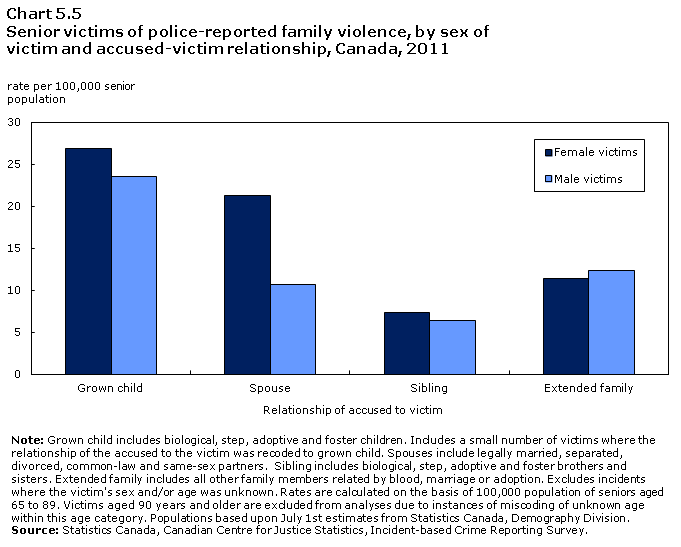
Common assault most common type of family violence against seniors
Common assault, in which little or no physical injury is caused to the victim, was the most common form of family violence against seniors. In total, common assaults accounted for over one-half (52%) of family violence incidents, followed by uttering threats (20%) and serious assaults (12%). These were the most common forms among both men and women (Table 5.4).
Most family violence against seniors involves physical force or threats
Similar to violent crime in general, family violence against seniors was most likely to involve physical force or threats, rather than the use of a weapon. More specifically, well over half (58%) of family violence incidents against seniors involved the use of physical force, while more than one in four (26%) involved threats. Weapons were used in the remaining 16% of incidents (Table 5.5). These trends were similar for both senior males and females.
In general, most seniors were not physically injured as a result of the family violence they experienced. Close to two-thirds (62%) sustained no physical injuries, while 36% sustained minor physical injuries, which required no professional medical treatment. In total, 3% of seniors received a major physical injury or died as a result of the family violence. These proportions were similar among both men and women (Table 5.6).
Family violence against seniors most often results in charges
Previous studies have found that many violent acts against seniors may never be brought to the attention of the police, particularly in cases where the accused is a relative of the victim (Sev'er 2009). The under-reporting of family violence may be even more prominent among seniors who are isolated from people outside their families, resulting in diminished levels of formal detection (Teaster et al. 2006; Grama 2000).
When family violence against seniors does come to the attention of police, it most often results in charges being laid against the accused. More specifically, more than half (54%) of family violence incidents involving seniors resulted in police laying a charge against an accused, with incidents involving senior female victims resulting in charges slightly more often than incidents involving senior males (Table 5.7).
Close to 3 in 10 (29%) family violence incidents involving seniors were cleared by other means, such as the victim declining to lay charges and departmental discretion. The remaining 17% of family violence incidents against seniors that came to the attention of the police were not cleared.Note 2
Rate of family-related homicide against seniors has decreased over past 30 years
Using data from the Homicide Survey, it is possible to look at the most serious form of violence against seniors and the motivating factors behind it. In 2011, the rate of family homicides against seniors was 3.2 per 1,000,000 population aged 65 and older. Despite annual fluctuations, the rate of seniors killed by a family member has declined over the past 30 years, falling 55% between 1981 and 2011. This drop in rates was driven primarily by a decreasing number of male victims. More specifically, the rate of family-homicide for senior males fell 80% between 1981 and 2011, while the drop in the rate for senior females was 26%.
Despite annual fluctuations, over the past 30 years, rates of family homicides have generally been higher among senior females compared to their male counterparts (Chart 5.6). In 2011, the rate of family homicides for senior women was more than double the rate for senior men (4.3 versus 1.8 per 1,000,000 population).
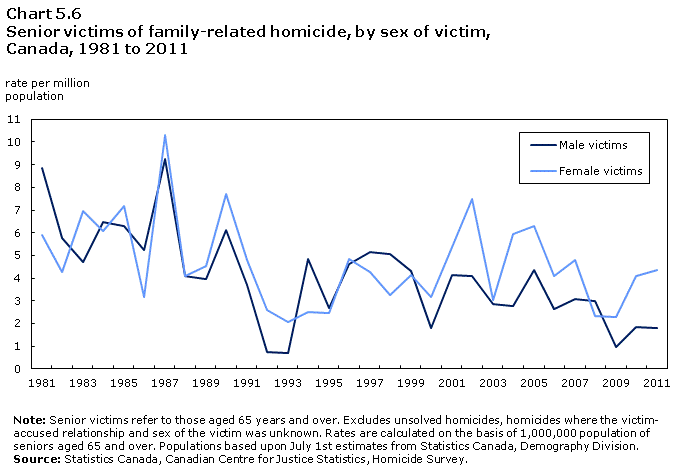
In addition to collecting information on the prevalence of homicide in Canada, the Homicide Survey also collects information on the nature of homicide, including the motives behind the crime. Among the most common motives were feelings of frustration, anger or despair on the part of the accused (34%) and the escalation of an argument (25%) (Table 5.8).
Motives for family homicides differed based on the sex of the victim. For example, homicides motivated by frustration and anger were more common among senior females compared to senior males. More specifically, feelings of frustration and anger were cited as the motive in 41% of senior female homicides, compared to 19% of senior male homicides. In contrast, homicides involving male victims were often the outcome of an argument between the victim and accused (Table 5.8).
Summary
Similar to previous years, seniors had the lowest rates of family violence compared to every other age group. Rates varied by the sex and the age of the victim.
Following similar trends as violent crime overall, rates of family violence against seniors were highest in the western provinces and in the territories. Further, as in previous years, rates of family violence against seniors were higher in small towns and cities compared to census metropolitan areas.
Common assault was the most common type of family violence experienced by seniors, followed by uttering threats and serious assaults. Most incidents of family violence against seniors involved physical force or threats rather than a weapon, and most result in no physical injury to the victim. Homicide, the most serious form of family violence, has been decreasing among seniors over the past 30 years.
Detailed data tables
References
Grama, J.L. 2000. "Women forgotten: Difficulties faced by rural victims of domestic violence." American Journal of Family Law. Vol. 14. p. 173-189.
Province of British Columbia. 2013. Together to Reduce Elder Abuse – B.C.'s Strategy. (accessed March 1, 2013). www2.gov.bc.ca
Sev'er, A. 2009. "More than wife abuse that has gone old: A conceptual model for violence against the aged in Canada and the US." Journal of Comparative Family Studies. Spring. Vol. 40, no. 2. p. 279-292.
Sinha, M. 2012. "Family Violence in Canada: A Statistical Profile, 2010." Juristat, Statistics Canada Catalogue no. 85-002-X.
Statistics Canada. 2012. The Canadian Population in 2011: Age and Sex. Statistics Canada Catalogue no. 98-311-X.
Teaster, P, K.A. Roberto and T.A. Dugar. 2006. "Intimate partner violence of rural aging women." Family Relations. Vol. 55. p. 636-648.
Notes
- Accused persons and victims aged 90 years and older are excluded from analyses due to instances of miscoding of unknown age within this age category.
- 'Not cleared' refers to incidents where an accused person has not been identified in connection with the incident.
- Date modified: